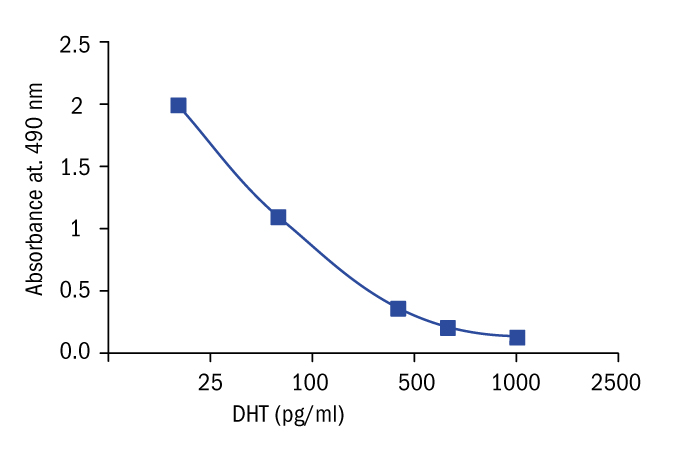Type
Competitive ELISA, Immobilized antigen
Applications
Serum
Sample Requirements
50 μl/well
Shipping
At ambient temperature. Upon receipt, store the product at the temperature recommended below.
Storage/Expiration
Store the complete kit at 2–8°C. Under these conditions, the kit is stable until the expiration date (see label on the box).
Calibration Curve
Calibration Range
25–2500 pg/ml
Limit of Detection
17 pg/ml
Intra-assay (Within-Run)
CV = 6.9%
Inter-assay (Run-to-Run)
CV = 8.5%
Spiking Recovery
95,8%
Dilution Linearity
95,40%
Research topic
Steroid hormones
Summary
5-dihydrotestosterone (DHT) is a steroid similar to testosterone and androstenedione, which belong to a vlase called androgens. DHT is a C19 steroid and possesses androgenic activity. The bulk of androgen production takes place mainly in the Leydig cells of the testes. Androgens circulate in the blood bound to proteins, especially sex hormone binding globulin (SHBG) and albumin. A trace amount of these steroids circulate in the unbound form in the blood and are referred to as the free fractions. DHT has at least three times the binding affinity for SHBG than testosterone. In males about 70% of DHT is derived from peripheral conversion of testosterone, while in females most of the DHT is derived from androstenedione. The major organ to neutralize androgens is the liver. Therefore in the liver the steroid hormones undergo structural modifications that are generally regarded as prerequisites for their biological inactivation. Some metabolites are formed and some are returned to the circulation
Instructions for Use (RUO)
Instructions for Use (RUO)
Safety Information (RUO)
MSDS (RUO)
Find documents for the lot

